Galvanized Pipe
2015-05-29 Off By Tom PestakTry, for a moment, to imagine the trepidation of Cavs fans (or just read through the twitter replies) when the #WojBomb detonated. The Cleveland Cavaliers, fragile, rudderless, running out of time, prepared a jersey and a locker for J.R. Smith. J.R. Smith?! With Smith’s reputation, it was almost inconceivable that Cavs GM David Griffin would risk further dysfunction on a team that needed to get righted quickly. The season was not yet completely unsalvageable, and Smith, for all his documented transgressions and the deafening chorus on his inability to be coached, could be considered one of the few role players in the NBA that could win a game by himself. Still, it was like calling for a Hail Mary on 3rd and 8 with a minute and three timeouts remaining.
New York is sending J.R. Smith to Cleveland, league sources tell Yahoo Sports.
— Adrian Wojnarowski (@wojespn) January 6, 2015
Here is one of my favorite scouting reports on J.R. Smith, courtesy of John Hollinger, who through the years seemed to revel in explaining the dichotomy of the mercurial sixth man:
Years from now, scholars will study the career of J.R. Smith and, despite the advanced intelligence of their machines, will still be unable to figure him out. There is simply no way to explain a player who, within the same season, hit at least five 3-pointers in a game 11 times, shot 9-for-36 in a five-game stretch, got benched, and finished the year by scoring 22 PPG on 48.1 percent shooting over his final 10 games. And that’s not even the full story.
(God I miss Hollinger the writer) Had the Cavs continued to underwhelm, the acquisition of Smith would have been met with “what were you thinking” type howling that may have broken the psyche of the Front Office. Much to the surprise of all humanity, the J.R Smith trade has worked out so well that pundits and talking heads have been struggling to ascertain how, exactly, this came to be. Maybe Smith realized this was his last chance to make good on his deep well of talent, maybe LeBron really has ascended to shaman-like status as a teammate whisperer, maybe Cleveland’s relative nightclub scarcity or the release of Mario Kart WiiU limited the impetuous Smith to the gym or the couch. The possibilities are endless. I don’t know why, and I don’t know how, but J.R. Smith was absolutely vital to the 2015 Cavaliers establishing an identity and realizing their greatness. Don’t take my word for it, here’s David Blatt:
I really can’t comment on anything in the past, but I can tell you one thing: J.R. Smith has been a dream for us, as a team and for me personally. I love the guy. I love coaching him. He comes to work every single day. He’s a great teammate. He’s playing both ends of the court for us consistently. He’s one of the main reasons for our turnaround, together with Iman, who simply started later because of the injury. Those guys, honestly, they’ve been a godsend. They really have. They turned the team around.
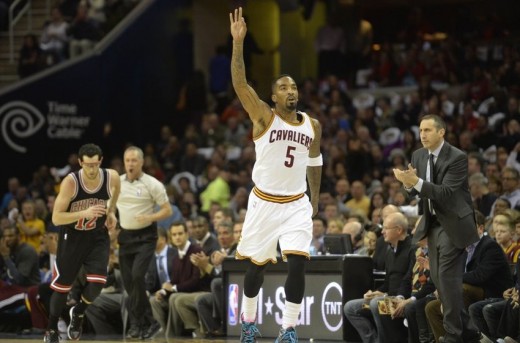
“I love coaching him.” ¯\_(ツ)_/¯
For a while it seemed as though J.R. simply suppressed his negative qualities, while occasionally transcending to video-game-like explosions.
https://www.youtube.com/watch?v=XyFiW-KtZD8#t=3m57s
But it was more than that. The fans noticed it first. J.R. was flying all over the court, fighting through screens, closing out on shooters, boxing out, and doing all the little things it takes to be a plus defender. I remember watching a game on Fox Sports Ohio about a month into the Smith era when Austin Carr embarked upon a solid minutes-long monologue to praise J.R.’s commitment to defense. He was exasperated, publicly admitted what we all privately felt, “Fred, I had no idea this guy could D-up like this.” Now, with every Cavalier game on national TV, the world has wondered out loud “where was this J.R. Smith in New York?!”
We don’t know. I’ve implied at times that Smith is mostly the same player, he’s just benefitting from a winning environment (recall Boris “man boobs” Diaw floundering on a 7-win Bobcats team before practically doubling his FG% after a mid-season trade back to San Antonio). In the regular season, this theory was viable, but it no longer accounts for what we’ve witnessed in the playoffs. This is a different player.
In the regular season, J.R.’s commitment to defense was palpable. This, the guy that John Hollinger reported: “Has zero interest in defending.” We witnessed J.R.’s activity and energy, but how effective was he?
First, we can peer into the Cavs’ Defensive Rating. The Cavs posted a 103.1 when Smith was on the court and a 103.1 when Smith was off the court during the regular season. These 103.1 marks are an indication that 1.) The Cavs were at least serviceable on defense post January-shakeup, and 2.) That J.R. probably wasn’t a defensive stalwart by any means. In the playoffs? The Cavs are 99.2 when Smith is off the court and 97.9 when he’s on it. In the playoffs, the Cavs have been a very good defensive team, and J.R. Smith is a part of that, although it’s hard to separate the effect he is imbuing versus his teammates. For that, we turn to the SAP analytical defense dashboards for J.R. Smith on NBA.com. The values shown are an aggregate of shots against which Smith defended.
Sure enough, J.R. was a plus defender during his regular season stint with the Cavaliers. In the above chart, DFG% is the Field Goal percentage of the player Smith was covering. The E[FG%] was the typical (or expected value) field goal percentage for that same player (including all the times Smith wasn’t guarding him). The Diff is self-explanatory, with a negative number meaning the player that Smith was checking shot the ball so many percentage points worse than normal. With an overall regular season Diff of -2.2, J.R. was dragging opponent’s field goal percentage down by a couple of percentage points. (For comparison’s sake, Kyrie Irving’s regular season overall Diff was +2.9.) But look at those playoff Diffs! Negative 8.3 overall and negative 12.1 on perimeter shots! And remember, this difference is between the actual and the expected value of the player that Smith is guarding, not simply the on-court/off-court difference of Smith which could be deceivingly deflated, due to the quality of playoff opponent. (If we want to ignore that Atlanta was a very good outside shooting team before running into the Cavs.) J.R. Smith has been severely hampering his opponents (relative to their non-J.R. Smith encounters) on the perimeter on defense. Who saw that coming?
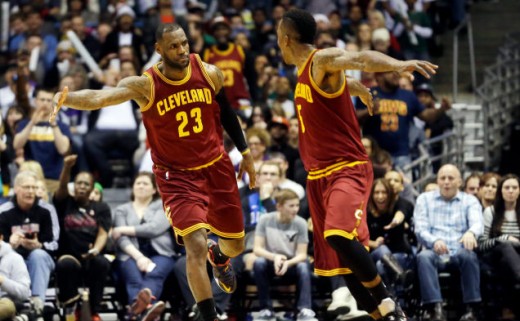
“I felt like for me, we were getting a great piece not only on the floor, but off the floor as well because I knew him before he even got to this point.” -LeBron
And what about J.R.’s offensive game? Let’s revisit Hollinger’s scouting report: “Ultimate streak scorer; no conscience in shot selection.” Sounds about right. So what do you do with a guy like that? You bring him off the bench, turn over the reins on offense, and hope for a spark. You expect to see about the same approach: dribble-heavy iso, lots of flashy crossovers, some egregious step-backs, and a shooter undeterred by misses. Shooters shoot. Here’s J.R. back in January:
Worse come to worse … my motto is, ‘When in doubt, shoot the ball.’ So when in doubt, I’m going to shoot it, and hopefully that don’t catch nobody off guard.
You just hope they go in. He’s a spark, an X-factor. We come up with this 3rd set of titles to describe a player like Smith. The other two classifications are: star and role player. The X-factor, when he’s firing on all cylinders, can be the best player on the court. When he’s sputtering, he can hurt you more than a role player, who knows his limitations and plays within himself.
Unlike the above sentiments would lead you to believe, J.R. Smith has had, throughout the playoffs, an X-factor’s ceiling with a role player’s approach. This is not very common, and it’s the first time in Smith’s playoff history that he’s done anything like this.
He’s logged 358 playoff minutes this season, that’s his second most, nestled between the 2008-2009 Nuggets’ playoff run (435 min) and the Knicks’ playoff campaign of two years ago (351 min). With those as comparables, here is how today’s J.R. Smith has changed.
J.R. played very well in the 2009 playoffs, and has struggled since. This season he’s been even better, and his approach has been pitch perfect. With Kevin Love out and Kyrie Irving limited, someone needed to replace the deadly outside shooting that had become a defining characteristic of the Cavs’ offense. As you can see, J.R. is setting a playoff career high in percentage of his shots that are assisted (denoted as %Ast), 3-point field goal percentage, effective field goal percentage, and, maybe most importantly, he’s been clutch as hell. Just look at that, when the score is within five points, J.R. Smith is shooting 21/43 from the 3-point line. This accounts for a full third of his shot attempts: 3-pointers (mostly assisted) with the score tight. Even in his superb 2009 playoff campaign, only a quarter of J.R.’s shots were taken with a tight score, and only half of those were assisted (more pull-ups and step-backs), as opposed to these playoffs where 72% of shots in this “clutch” situation are assisted. For comparison’s sake, 2013 NBA Finals Champion, Ray Allen, had an eFG% of 55% (a full 11 percentage points less than Smith) when the score was within five points and 71% of those shots were similarly assisted.
J.R. Smith is also setting per-minute, playoff career highs in: steals, rebounds, and turnovers (lack of). He’s dribbling less, isolating less, driving less, but his activity is not down. He’s embraced his role as a 3-point sniper, and limited the shot attempts that built his “no conscience in shot selection” reputation, while expanding the breadth of his defensive approach.
It’s not like J.R. Smith has completely suppressed his irrational swag in favor of textbook, team-oriented mechanics, (the quote above is only a week old) and I mean this in a good way. There are only a few “role players” in the NBA capable of making these shots. These are the shots of an X-factor going full tilt.
https://www.youtube.com/watch?v=zb0SJFfOdF4#t=36s
It’s not a stretch to say that J.R. Smith saved the Cavs’ season with his 4th quarter barrage in Game 4. Prior to these difficult, contested, irrational-confidence bombs, the Cavs had managed a meager four points in over nine minutes. A seven-point deficit with 10 and a half minutes remaining seems a lot more insurmountable when you’re averaging just a point every 2:20.
No, Earl the Third is still J.R. He’s just playing smarter, harder, and using his supreme talents as a shooter to elevate a LeBron/Kyrie-centric offense. He’s largely resisted the urge to showcase the dribble-heavy escapades of his pre-Cleveland days, without losing an ounce of pipe-laying swag.
https://www.youtube.com/watch?v=SoqNwcRRDZ4
One of my favorite moments of the playoffs was J.R.’s decision to blow by Kyle Korver to dish an alley-oop to TT, in lieu of a very-much-earned heat check. Kyle Korver was defending the scouting report. J.R. Smith is re-writing his scouting report.
Acknowledgements:
The hilarious title picture is courtesy of Justin Rowan of FearTheSword.
All stats were taken from basketball-reference.com and NBA.com.


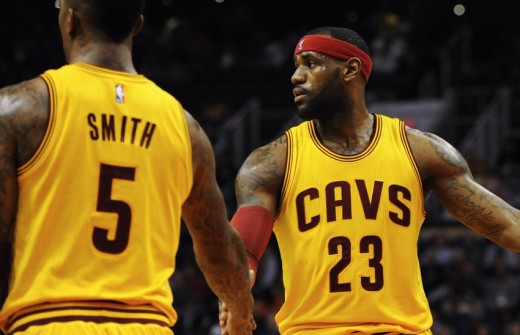
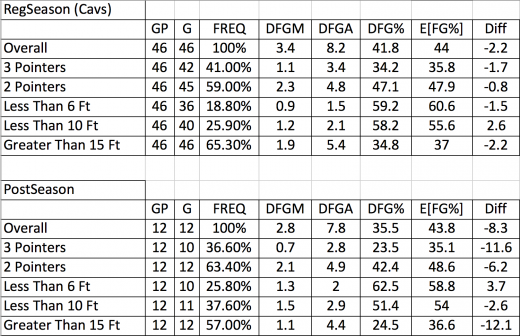
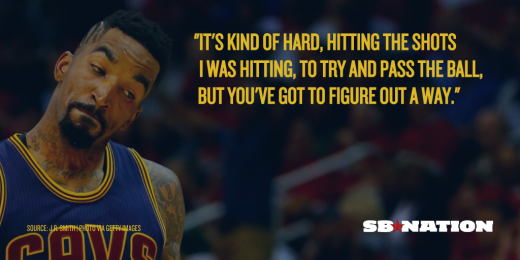

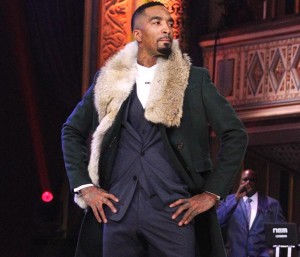
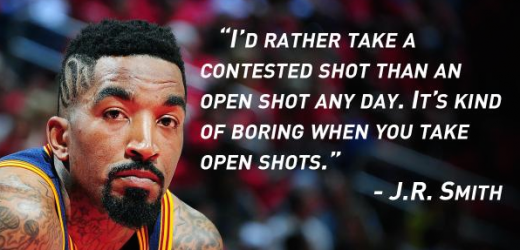
I really believe the Cavs will win if Blatt figures out to play to the Cavs strength and not react to the Warriors. When the Warriors go small, I hope he doesn’t feel the need to match them. We don’t match up with them going small. Mozgov, TT and LeBron on the front liine should dominate. And with Kyrie, Smith and Shumpert, they should hold their own against the Smash Brothers. It has always been staggering to me that Mozgov doesn’t get much time in the 4th quarter. Mozgov, TT, LeBron, JR and Iman are the best defensive five of… Read more »
Mozgov is probably going to get some 4th-quarter play this series. GSW hacked Dwight Howard to keep him out late, and they’ll probably do the same to TT.
If they do that to TT, they will probably pay. TT shoots FTs at a much higher rate than what would be profitable for them. Could be good in a some short term for them, of course. (or bad)
Cavs have been very successful with small lineups as well. TT, Lebron, JR, Shump, and Delly/Kyrie have destroyed teams in the post-season.
Defensive execution, effort, focus is what will determine the series. Cavs have to limit GSW’s pace, ball movement, and penetration. A very tall task, the tallest this team has faced all year. I believe they have the coaching and roster to meet that task.
@ChrisBHaynes: Kevin Love’s injured shoulder re-aggravated after teammate hit his arm while celebrating Finals berth http://t.co/uzogyvO6VG
It was probably Delly because he’s dirty. Lol!
Hahaha #BlameDelly
Video footage of Kevin’s press conference. http://www.nba.com/video/?ls=iref:nba:gnav#
Not at all the demeanor of someone unsettled.
He really was in good spirits, his body language said allot
Love will be a decent 12th man. J/k
But you know the ESPN opinion makers will fill their crappy 3 hour slots with this come Monday. Hot takes will abound.
I really liked this article. Great insights into just how much focus Lebron has put on trying to bring this team up to his level rather than carrying them like he did with that 2007 crew. This article explains the difference between the two squads, and explains why having veterans who get zero playing time is valuable. Love the Perkins portion…he may have given Mozzy just enough extra backbone to keep him on the court when we need him.
http://www.nba.com/2015/news/features/ian_thomsen/05/30/lebron-james-and-his-cast-of-cavaliers-characters/index.html
“LeBron and his cast of Cavs –
Can a rotation of role players help the King beat the Warriors?”
If they can, LeBron’s legendary status certainly moves up a couple of notches.
For sure. If he can bring this group of cavs a championship against this kind of opponent (not that wimpy okc team he and the heat throttled for his first title) he will definitely never be doubted again.
I love this part: “No one feels alone, although the support is shared in some unusual ways. Mozgov, who two seasons ago was a DNP for half of the Nuggets’ schedule, instantly provided the Cavaliers with a massive presence around both baskets. But was he ready for a two-month run at the championship? Kendrick Perkins, the backup center signed by the Cavaliers in February, insisted on making certain. During their second practice of the playoffs, he clobbered Mozgov in the paint relentlessly until his teammate wheeled around to complain. That was when Perkins announced for the entire team to hear,… Read more »
Favorite national media piece since “The Letter” which got me right in the feels.
@TheKennyRoda: Listen 2 entire #Cavs @kevinlove press conference as he addressed his future,the Finals & LeBron as MVP -listen here- http://t.co/zCoPBh7yhn
Thank you, awesome to hear him!!
Yes, thanks Arch. I think that’s the most I’ve heard him be upbeat and reveal about himself since he came here. He obviously sounds very happy being a Cav.
Everyone must bear in mind that he cannot say definitively that he’s coming back because he loses negotiating leverage and stands to lose millions of dollars by doing so. However, it’s obvious he loves this team. No player should ever say definitively that they’ll be back unless a deal has already been struck. That would be stupid.
Windy must be heartbroken about KLove’s comments…
And the rest of the national media.
WHAT ARE THEY GOING TO TALK ABOUT!?
They’ll ignore what he said. After Love’s comments today, what’s the over/under on how long until someone puts out a new “Top Five Free Agency Destinations for Kevin Love”? Five days? Three?
They’ll say players say stuff like that all the time, and still do otherwise. The “Love is gone” narrative is strong like bull.
You’re right, its absurd. I don’t know what I was thinking. As for an over/under, I would actually think closer to 7+ days. Who knows, I’ve already given them too much credit.
I heard today that Cavs will trade him, what a joke! Stories never end with the Lebron train. It does seem like now the media is starting to realize that the Cavs are for real and they just might beat warriors. They don’t want to be left out of that. Go Cavs
@CavsFredMcLeod: I can tell you after watching Kevin again today, and seeing him with the guys in practice, he is in a very good place, as can be expected
@CavsFredMcLeod: “Yes I do” when asked if he thinks LeBron is the MVP of the playoffs so far…(that brought laughter from the throng after prior MVP talk)
Either Love is a liar and completely trolling the CAVS or he’s being honest and the National Media is desperate for a story. I’ll go with the latter.
@RuiterWrongFAN: Love says he excited at prospect of #Cavs (barring injury) being title contenders for years to come
@mcten: Kevin Love on next season: “I truly expect to be suiting up for Game 1.” For the Cavs? Love: “Yes, sir.”
@ChrisBHaynes: Kevin Love says he expects to be suiting up for #Cavs next season.
@CavsFredMcLeod: Kevin says he sent Kelly Olynyk a text and said “it’s all good”
If Kevin Love can’t let it drop with Kelly Olynyk – I can too.
Meant to say – I Love “CAN” let it drop – I can too.
@ChrisBHaynes: #Cavs F Kevin Love says he’s confident he’ll be able to suit up by October, November. Says he’s proud of what his guys have been able to do.
@CavsFredMcLeod: Says he hopes to be ready to go by Sep-Oct…”it’s been tough to sit, but the way guys have stepped up, it’s been a lot of fun to watch”
@twithersAP: #Cavs forward Kevin Love will speak to the media today for first time since his shoulder surgery.
Off topic . The Cavs Vs Warriors Game played at the Q on Feb 26th is replaying now on NBA TV. 9 min left in the second quarter.
My fear with Smith Jr is that when the season is over he’ll go back home and get sucked into the bad ways. Half the stories about him also include family. It’s a poisonous group and Cleveland was probably the location keeping them away. As for Dion, always disliked him, read as far back as the draft if possible. Red flags should be flying when a talented guy can’t get off a college bench. His ego is probably similar to JR but he doesn’t have the same talent. Dion is best served starting on a garbage team scoring 25 a… Read more »
http://www.postingandtoasting.com/2015/5/28/8677041/19-things-i-learned-about-the-knicks-by-watching-the-nba-playoffs
This was funny, as well as the comments
It really was funny
21. Steve Kerr and David Blatt are rookie coaches, and going to the NBA Finals. Derek Fisher is also a rookie coach, but is not going to the NBA Finals. Knicks bad
Did basketball genius Phil Jackson engineer this trade for the Knicks?
He really does have the magic touch when it comes to creating championship caliber teams.
Jackson as a GM was always laughable. He doesn’t want to travel, thinks analytics are overrated, and is still trying to implement the triangle. He forgets that you need Jordan, Pippen, Kobe, and Shaq to make the triangle work.
When the Cavs added Smith and Shump, I don’t think that any of us thought that we’d be getting two 2-way players, and not just that, two players who would mesh so well personally with Lebron. The latter cannot be underestimated – these dudes bring a ton of swag, which is something that this team was sorely lacking.
Absolutely excellent point, Raff22.
We had all heard that Imam was good on D, and knew JR could light it up on O, but both are doing great on both PLUS rebounds and steals!
Best. Trade. Ever.
BTW, Cavs in six. I am with Cols this time, and saying what I think.
From Terry Pluto’s article today:
I love this quote from Shumpert about catching a James pass: “Him snapping that ball at you … there is energy in the ball when you get it.”
More from the article:
“After gushing about what James has meant, Blatt recently made a good point: “Part of what he’s doing so well has to do with his teammates reading and responding to him in the proper way.”
The Cavs’ spacing has been very good. Players are available for passes from James. They are cutting to the basket at the right time. They are clearing out when he wants to take his defender to the rim. It’s been impressive.”
http://www.cleveland.com/pluto/index.ssf/2015/05/cleveland_cavaliers_have_terry_8.html#incart_river
More:
“Blatt had an interesting moment after the Cavs swept the Hawks. Standing next to assistant Larry Drew, they began talking about a few years earlier when Drew was the Hawks’ head coach. Drew had traveled to Tel Aviv to spend time watching Blatt’s practices. Blatt said they recalled sitting on a Tel Aviv pier, talking about life and their future. Who knew it would include Cleveland and the NBA Finals?”
That Shump quote is great.
Can’t believe Scott Skiles got another gig. He’s not much of a players coach, that’s for sure. I give it two years before the Magic stop playing for him.
They won’t be wearing any headbands on the Magic with Skiles.
I don’t get how they hired anyone other than Thibs.
You absolutely crushed it again. You really are a better writer than many of the national big names…Hollinger getting his gig with the Grizzlies was a yay/boo moment for me. I was happy for him getting to influence an actual team, but I was bummed that we wouldn’t get his awesome analysis anymore. J.R. really is the wild card in this series. If he goes off three or four times, the Cavs probably win the title. He not just playing for a contract, but for his legacy. Biggest two weeks of his career. If he comes through the past won’t… Read more »
thank you my man! I’m actually surprised how little attention he and Shumpert are getting. It’s been all LeBron, Delly, TT, Blatt in that order. Shump and Smith have been HUGE in the playoffs
Shump and Smith have been great in the playoffs. Like really great. Smith is pulling down tons of rebounds and making tough shots all over the place. Shump has been playing great defense and occasionally getting hot.
They are why I think we can beat GSW, well, besides LeBron and Kyrie.
I think Vegas has 75-1 odds on JR being the Finals MVP. He’s just the type of player that can pull it off – especially the way he’s been playing lately.
Somebody wrote in an earlier blog about JR being like your college roommate to never studied and never tried very hard at stuff and just had fun – yet was pretty successful in everything he did. (You, on the other hand, followed him and struggled.) Well, he decided he was going to study this year . . . we’ll find out what that leads to.
Tom, great article. You are right to give him credit–I felt the Cavs MOPs in descending order over the last to series has been LeBron, TT and JR, even when JR doesn’t score 28 or go insane from 3…he grabbed double digit rebounds in a game! His block AROUND the big in game four said SO MUCH about his willingness to defend. The storylines purported by national media, I thought, would at some point come around to the 180 JR has done on the court, but they would rather discuss how “average” LBJ was in his near triple-double series (Steven… Read more »
I think it’s good when people pay attention to Lebron & Delly, and not JR, TT, and Shump. Let them gameplan for Delly all they want.
I’m sure everyone here is aware that, while LBJ has zillions of adoring fans, he seems to have just as many that would love to see him fail. (Media people included.)
Not just one 10 rebound game…. but TWO in a ROW! Just incredible
Both have been phenomenal. If Shump can drain one of the slash brothers he’s getting $12 million a year.
agree that the quality of work at CTB is so good now, i prefer it to most grantland/espn columns. Thanks to all of you for the time and energy.
HAs there ever been a better trade in Cleveland Sports history?
Or a better blog?
I have not sampled a lot of blogs, but CtB is FAR better than any other one in sports that I have seen.
Congrats to all (you too, Cols).
I like the writing on this blog and the commenters. But I really like the commenting functionality and community at FTS. This blog needs a tech upgrade.
The functionality isn’t bad, but I could never seem to get into the vibe at FTS. I’m obviously biased, but I just feel like they’re a lot heavier on “news” and less reliant on opinion, analysis and entertainment. Early on I decided I only had enough time in my life for one Cavs Blog, and I chose this one.
#loyalty
Pretty much agree with Evil on this. CtB has a good mix of informed opinion, give and take, and is an all around fun experience.
It was a great idea to hire Cols to take goofy stands, so the rest of us would have someone to argue with!
Agree with Raoul
Esmil Rogers for Yan Gomes and Mike Aviles was a better trade.
I would buy this argument if the Indians had made it to the World Series…
Nice job as usual, Tom. J.R. Has absolutely shocked me this year. It has been a magical turnaround for him since he came to the Cavs. That said, I would be somewhat terrified at throwing big money at him.
Saw Kyrie said he would probably be on Curry, speaking of terrifying things.
That could mean they’re taking the tack of making Steph Curry be a scorer instead of letting him run the offense. Either way, I think we’ll probably try Kyrie and Shumpert at different times in Game 1.
Kyrie was a good defender this year. Kyrie, if healthy enough, will rise to the occasion. He has a little trouble with penetration, but that’s where Moz and others come in. I think Kyrie plays the perimeter well. He’s heady and will pick your pocket every now and then.
We keep talking about who’s guarding who. In today’s NBA everybody guards everybody . . . which is why it’s good that our guards have some size and JR, Shump, & Kyrie can block a shot.
Great write up. Remember the Dion is better than J.R. discussion? Those were fun times. Speaking of Saint Weirdo, it makes me sad to think about him. He is sooo much more gifted than a guy like Delly. If he wanted to, he’d be the better defender, shooter, ball handler, rebounder, and passer and could have been a hero when KI went out. But his refusal to buy into the team put him on the couch for the playoffs. I guess we should be thankful because his departure gave us Shump, J.R., and Moz. What a dumbass. I hope he… Read more »
Lovable but horribly flawed player….best of luck Dion!
I never thought of it that way, but you’re right. Delly is contributing at a higher level than a No. 4 overall pick. Wow.
Another example why the Sam Hinkie tank to win team building strategy is just intellectualized cowardice. Good GMs find talent wherever it exists. Look at what Daryl Morey accomplished with the Rockets. The Dubs drafted Klay, Steph, Draymond, Barnes etc. without high lottery picks and got Bogut for Monta Ellis, a mid second round pick. Shumpert, Tristan, JR, Mosgov, these are all precisely the kind of “good, not great” players that Hinkie doesn’t want on his team. The problem is, you need those guys to win in this league, you’re never going to have a team with six Lebrons no… Read more »
Delly is probably contributing more than a recent #1 pick. RIP Gumdrop Bear.
Poor Gumdrop. RIP Chris Grant.
Delly might better than anyone drafted in the top 10 that year.
We didn’t need another shooter at the time. We needed a freakin center. It’s really that simple. Dion’s and JR’s stat at THAT point in the season were identical. It was a wash again at THAT point in the season. Dion wasn’t complete garbage or we wouldn’t get sqat from OKC. Nuggets demanded two 1st rounders. We got a first rounder from OKC so we could get Mosgov. Everyone seems to forget Dion was still young on his way to get better. Jr had 8 years under his belt already. What is amazing if you look at Paul George’s stats… Read more »
It really worked out for both parties to go to different teams.
Dion is, what I would call, a very talented player with a fatal flaw. He’ll make a name for himself before he’s done, but with Dion on your team – the total performance is not greater than the sum of its parts. Right now, the Cavs team performance is greater than the sum of the parts. We always moaned about chemistry when Dion was on the team.
When pundits and Cavs fans compared the Cavs with Chicago and Atlanta many gave the edge to the opponent because they were only considering the parts.
Dion Waiter’s ceiling is Steve Francis.
Maybe my post came across the wrong way. I loved Dion. Still do. At the time, he was the toughest guy on the team and was incredibly talented. But He couldn’t get over his belief that he was the best player on the team and the smartest guy in the room. I think he’ll have good career. I was just pointing out how much more physical gifts he has, but because of arrogance, or over-confidence, or selfishness, or insecurity, whatever you want to call it, he couldn’t contribute to a team that is now in the finals. There is no… Read more »
JR Smith is RIGHT NOW the player we all hoped Dion would one day become.
Not at all. Manu ginolbli is what we hoped he could be
EVIL THANK YOU FOR THE (2 ) PICTURES —THE ONE FEATURED HERE ( STLL LAUGHING –WONDER IF COLS REALLY LOOKS LIKE THAT ) AND ALSO THE ONE YOU SENT ME —-YOU ARE THE MAN !!
No problem NOMAD! Happy to oblige!
Great article Tom. I have to admit that I thought JR was poison and the trade was a mistake . . . I was completely wrong, I am glad to admit now. Some players just need to be in the right winning environment (Rodman with Bulls, Horry with Lakers/Spurs etc.), they don’t do well when they are on bad teams with crappy management. If you read the old Sherlock Holmes stories, he took cocaine and basically drugged himself into a catatonic state when he didn’t have a case because he couldn’t handle being bored. I imagine some NBA players are… Read more »
Getting ready to watch again the second meeting between the Cavs and the Warriors this season. I want to see what adjustments did the Cavs made on Curry.
I keep thinking about the 2012 finals between the Heat and Thunder and to be honest if the Heat won that series with KD and Westbrook averaging 31 and 27 respectively I really believe the Cavs have a chance IF Kyrie can get at least 20 ppg.
Let Curry get his and keep the others in check.
No. Control The splash brothers, make everyone else beat you. Anyone aware of a headline this season to the effect of “Barnes/Green/Bogut/Iggy lead Warriors to victory?” I’m not.
I’m with Grover on this one. You can’t “let Curry [and Klay] get his.” When he sees a few open looks and knocks them down, that’s when he starts hitting EVERY SINGLE SHOT HE TAKES. It’s like JR, but more often. Contest the three point line and make them work on offense. Make guys like Barnes and Green prove that they can hit shots CONSISTENTLY to beat us. That’s usually what separates the good from great, the consistency. The good thing is, I think the game plan/style of D we played against Atlanta is going to be very similar to… Read more »
Good comment re: KD & Westbrook in 2012. Good point of comparison. Other teams have certainly outplayed the Cavs over stretches of games, but it doesn’t hold up over 48 minutes.
great article –I think the “circus ” in new York caught up with his play / performance ( along with all the other players ) the move to Cleveland / less distractions -media / the leadership of LeBron and JR knowing there was something ( nba championship ) to play for –his defense does not really surprise me with his length / athleticism / instincts it was just waiting for the right team to motivate him to showcase these talents —POOR COLS LET’S ALL CHIP IN AND DONATE THE MONEY OWED TO HIM !!
I WANT MY $50!!!!!!!!!!!!!!!!!!!!!!!!!!!!!!!!!!!!!
Cols is like…
haha, Cols does deserve the money . . . dude was right! Pay the man!
Great piece, Tom! While the eye test on JR has been clear with some of his on-court offensive displays, it’s truly amazing to see the statistics on just how much impact JR has had on the defensive end of things. Griff really did get just an embarrassment of riches from the Knicks. Maybe one of the greatest mid-season trades of all time…
It really was. Only other really great midseason trade I can think of is Sheed to the Pistons. They went from good to champs.
Pau to the Lakers was midseason in 2008. They lost in the finals that year, but then won two straight.
Maybe the greatest mid-season trade of all-time-in any sport, in any galaxy, at any time. Griff deserves an equivalent of Lebron’s salary for this all-time move.
Curry > Kyrie
JR Smith = Klay
LeBron >>>>>>>>Barnes
TT = Draymond
Mozgov = Bogut
I think we win this.
Klay is better than JR. Sorry.
Not so far in the playoffs. Thompson did have a good game closing out Houston, but he still has to sustain that to prove that he’s back.
Curry will be facing an elite defender in Shumpert. Depending on how healthy Kyrie is, that matchup might even be a wash.
Serious analysis going on here. Bravo.
My gawd, I laughed a little too loud at work when I saw this headline and photo.
So did I. Freaking hilarious.
JR is the most important piece outside of LeBron and Kyrie to this team right now. Thanks for the write up.
The more I think about it the more I think the Cavs win this series.
TT disagrees with you.
Love this article on JR. Nice job, Tom.
Of equal importance for the Warrior series: Klay Thompson has a concussion:
http://espn.go.com/nba/playoffs/2015/story/_/id/12976292/klay-thompson-golden-state-warriors-concussion
Ugh. Feel sorry for the kid. I don’t understand why they didn’t take him out, probably didn’t help him to go back in so quickly.